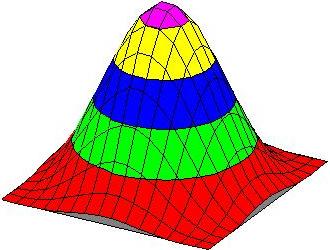



Density kernel estimation

What's it all about?
A method is proposed for particle
models to predict smoother concentration fields (and thus to speed them
up accordingly), by assigning a density distribution to every particle,
instead of the less efficient and (at the same time) less accurate box-counting
method. When concentrations are to be estimated, the size of these density
distributions (called kernels) is chosen by optimizing between a smooth
spatial concentration density and its oversmoothing.
Kernels vs. box-counting
Stochastic particle models
are the state-of-science method for modelling atmospheric dispersion. They
simulate the released pollutant by a large number of particles. In most
particle models the concentrations are estimated by counting the number
of particles in a rectangular volume (box-counting). The effects of the
choice of the width and of the position of these boxes on the estimated
concentration is investigated. For the estimation of the concentration
at a given point in space, it is shown that this numerical procedure can
cause either oversmoothed predictions or too much scatter. As an alternative
approach, the density kernel method to estimate concentrations is proposed,
which optimizes bias and variance. It allows for a reduction of the number
of particles simulated for the same accuracy. The efficiency of several
density kernel shapes is compared, and methods for choosing their bandwidths
are proposed. The relationship between the numerically motivated bandwidths
and the description of the growth of a cluster of pollutant particles (puff
dispersion) is discussed.
Further information...
...can be found in Chapter
4 of my PhD.
Or send me an e-mail: peter@dehaan.ch
Back to: Peter
de Haan's home page. last update: 4 Oct 2000 - PdH



